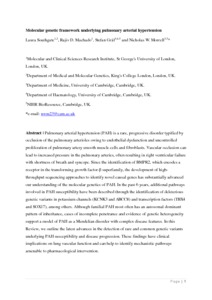Southgate, L; Machado, RD; Gräf, S; Morrell, NW
(2020)
Molecular genetic framework underlying pulmonary arterial hypertension.
Nat Rev Cardiol, 17 (2).
pp. 85-95.
ISSN 1759-5010
https://doi.org/10.1038/s41569-019-0242-x
SGUL Authors: Southgate, Laura
![[img]](https://openaccess.sgul.ac.uk/111104/1.hassmallThumbnailVersion/Southgate%20et%20al_NRC2019_accepted.pdf)  Preview |
|
PDF
Accepted Version
Available under License ["licenses_description_publisher" not defined].
Download (473kB)
| Preview
|
Abstract
Pulmonary arterial hypertension (PAH) is a rare, progressive disorder typified by occlusion of the pulmonary arterioles owing to endothelial dysfunction and uncontrolled proliferation of pulmonary artery smooth muscle cells and fibroblasts. Vascular occlusion can lead to increased pressure in the pulmonary arteries, often resulting in right ventricular failure with shortness of breath and syncope. Since the identification of BMPR2, which encodes a receptor in the transforming growth factor-β superfamily, the development of high-throughput sequencing approaches to identify novel causal genes has substantially advanced our understanding of the molecular genetics of PAH. In the past 6 years, additional pathways involved in PAH susceptibility have been described through the identification of deleterious genetic variants in potassium channels (KCNK3 and ABCC8) and transcription factors (TBX4 and SOX17), among others. Although familial PAH most often has an autosomal-dominant pattern of inheritance, cases of incomplete penetrance and evidence of genetic heterogeneity support a model of PAH as a Mendelian disorder with complex disease features. In this Review, we outline the latest advances in the detection of rare and common genetic variants underlying PAH susceptibility and disease progression. These findings have clinical implications for lung vascular function and can help to identify mechanistic pathways amenable to pharmacological intervention.
Statistics
Item downloaded times since 15 Aug 2019.
Actions (login required)
 |
Edit Item |



